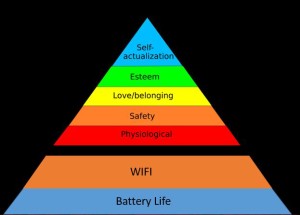
© 2009 Lisa Padilla, Flickr | CC-BY | via Wylio
We met at my favorite spot – McDonalds, the home of free wifi and endless sweet tea. The man immediately began to open up about his son, and how proud he was of his academic achievement and occupational accomplishments. At twenty years old, his son was not a slacker or self-absorbed like most other Millennials (if you believe the media). He was already financially self-sufficient, and held down a career job. But in spite of his fatherly pride, something had robbed this father of the ability to enjoy his son.
His son was the last of four children, and had been born to the father much later in life. The father expressed how often he struggled to understand his son in ways that he did not have with his other children who were almost ten years older.
 He had asked his son to refrain from tattoos until he was twenty-one. The father’s reasoning included the under-developed brain of emerging adults, his spiritual viewpoint of tattoos, and their long-term impact upon the individual’s body. Although he couldn’t imagine how anyone would want a tattoo, he would allow his child this option at the proper age.
He had asked his son to refrain from tattoos until he was twenty-one. The father’s reasoning included the under-developed brain of emerging adults, his spiritual viewpoint of tattoos, and their long-term impact upon the individual’s body. Although he couldn’t imagine how anyone would want a tattoo, he would allow his child this option at the proper age.
The son ignored his father’s wishes, and the father’s disappointment was obvious. He was trying not to take his son’s decision personally, but it still hurt. The reasons not to get a tattoo were so clear to him. Why would anyone get a tattoo when “style” change so frequently? He used the word “style” in reference to tattoos several times during our discussion.
I asked what he meant by “style” and he said. “In our world clothing styles change every season, and hair styles change once every couple of months. Why would you get a permanent tattoo?”
While growing up, I often heard people associate tattoos as a trend. With a larger portion of the population getting inked in today’s world, few would categorized tattoos as a style or fad that changes change with time. In my discussions with emerging adults, the decision to get a tattoo often reflected a life event, core belief, or part of their identity (more – Sacred Ink).
They are the opposite of a fad, but tattoos often reflect a person’s longing for permanence and search for uniqueness. The process of globalization has made it even more difficult for people to establish their own place in our world. Tattoos are a simple way for humans to create a marker of their identity.
As I began to speak, there was a beautiful moment as for the first time, the father understood his son’s perspective. We sat in a quiet moment. When our time ended, he turned to me and said, “I have learned a lot. We should talk again.”
 Another day in the life of a generational mediator.
Another day in the life of a generational mediator.
Dr. G. David Boyd is the Managing Director of EA Resources, a non-profit that seeks to equip churches and parents to minister to emerging adults.








 Do you know what the hell you’re doing? Because we’re coming clean and admitting that often times we don’t.
Do you know what the hell you’re doing? Because we’re coming clean and admitting that often times we don’t.

 Mark Whitt writes about why the Collegiate Day of Prayer matters to your college ministry. He is the Collegiate and Young Adult Specialist at LifeWay Christian Resources. Before joining LifeWay, he spent many years on the campus of Murray State University as a campus minister.
Mark Whitt writes about why the Collegiate Day of Prayer matters to your college ministry. He is the Collegiate and Young Adult Specialist at LifeWay Christian Resources. Before joining LifeWay, he spent many years on the campus of Murray State University as a campus minister. The concept of Think Orange, a book written by Reggie Joiner, states the influence of the church and family working together makes a greater impact than those same two influences can have individually. This ministry philosophy seeks to unite family and church to have a stronger spiritual impact on children and adolescents.
The concept of Think Orange, a book written by Reggie Joiner, states the influence of the church and family working together makes a greater impact than those same two influences can have individually. This ministry philosophy seeks to unite family and church to have a stronger spiritual impact on children and adolescents.


 So it happened. You thought you’d be on your own by now, but you’re not. Whether you’re trying to land a steady job, get out of debt, or finish college on the eight-year plan, if you’re living with your parents as a 20-something, you’re not alone. More than a third of 18 to 31 year olds are living with their parents, according to the Current Population Survey.
So it happened. You thought you’d be on your own by now, but you’re not. Whether you’re trying to land a steady job, get out of debt, or finish college on the eight-year plan, if you’re living with your parents as a 20-something, you’re not alone. More than a third of 18 to 31 year olds are living with their parents, according to the Current Population Survey.  Over the past few years, the percentage of 25-to-34-year-old Americans living with their parents has been at a
Over the past few years, the percentage of 25-to-34-year-old Americans living with their parents has been at a